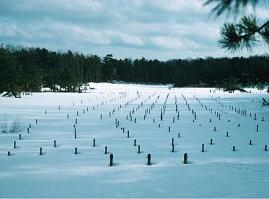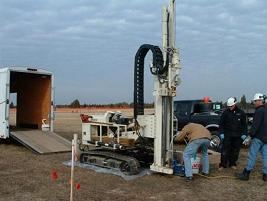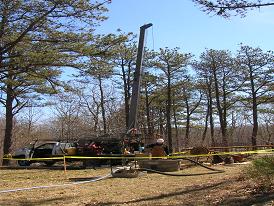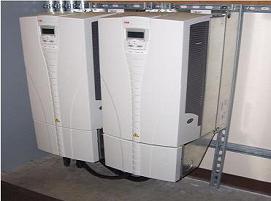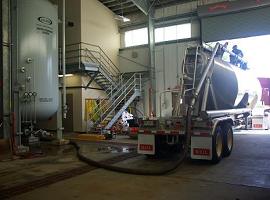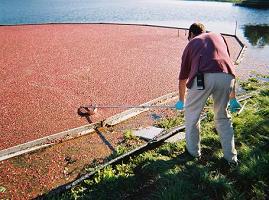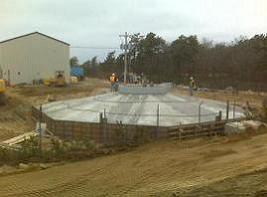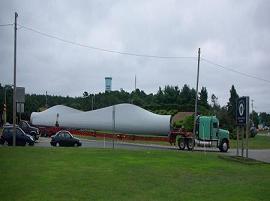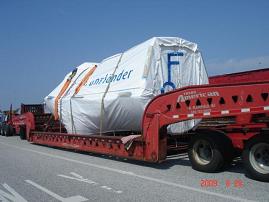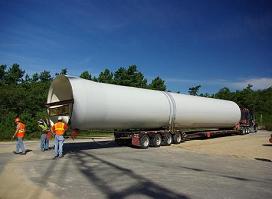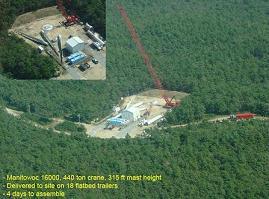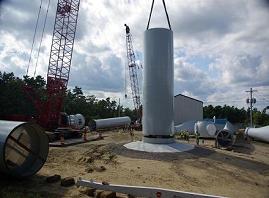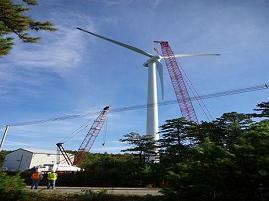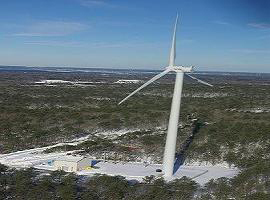Green Remediation Focus
Massachusetts Military Reservation
Cape Cod, Massachusetts
Federal Facility, Superfund NPL
Cleanup Objectives: Remediate 11 groundwater plumes across the 22,000-acre Massachusetts Military Reservation (MMR) site, including long-term operation of nine pump and treat (P&T) systems to treat approximately 14.5 million gallons of water each day. Contaminants of concern are trichloroethene, tetrachloroethene, and ethylene dibromide in groundwater at depths of 100-300 feet; other contaminants include carbon tetrachloride, vinyl chloride, 1,4-dichlorobenzene, 1,1,2,2-tetrachloroethane, RDX (CS-19), benzene, toluene, manganese, thallium, and lead.
Green Remediation Strategy: Optimize the existing systems for groundwater extraction, monitoring, and treatment; implement energy conservation techniques; deploy a renewable energy system to offset the high rates of P&T electricity consumption and associated air emissions from power plants; and employ a range of BMPs addressing all core elements of green remediation
Optimization of Groundwater Extraction
- Determine feasibility of shutting down any extraction wells no longer needed in a 100-well network that had operated since the late 1990's
- Investigate the impact of reducing pumping rates at each well or increasing extraction rates where needed
- Test efficacy of using pulse rather than continuous pumping processes at selected wells
- Packer well screens wherever warranted by changing parameters of contaminant plumes
Optimization of Groundwater and Performance Monitoring
- Convert to passive sampling techniques and identify potential adjustments to sampling locations, frequencies, and target analytes, to minimize purge water volumes and reduce a laboratory sample volume exceeding 5,000 at 3,000 locations in 2003
- Purchase a direct push rig instead of subcontracting conventional rotary drilling equipment and labor for subsurface sampling, which cost approximately $670,000 in 2003
- Convert from conventional diesel to biodiesel for powering the direct push rig and routine well maintenance vehicles such as medium- and light-duty trucks, and begin using biodegradable soy-based hydraulic fluid for all equipment
Optimization of Treatment Processes
- Conduct energy audits of all (nine) P&T systems and administrative facilities and implement the recommended energy efficiency improvements
- Begin recycling granular activated carbon (GAC) needed in all the P&T systems, which in 2003 totaled a volume of 1 million pounds of virgin carbon at a cost of $800,000
- Investigate potential for beneficial reuse of treated water prior to its return to the underlying aquifer
Renewable and Passive Energy
- Install a natural gradient-driven permeable reactive barrier (PRB) containing reactive zero-valent iron along the shore of an adjacent pond to minimize phosphorus upwelling into the pond
- Install an onsite wind turbine to meet a portion of the total P&T energy demand (12,300 MWh each year), based on results of a renewable energy assessment that found optimal conditions for wind energy (including an average wind speed of 7.0 meters/second and wind shear of 0.27)
- Evaluate potential for substituting or supplementing P&T technology with in situ "polishing" technologies such as in situ chemical oxidation or monitored natural attenuation in subareas where significant reductions in contamination concentrations have been achieved
Results:
Optimization of Groundwater Extraction
- Completed shutdown of 62 wells no longer needed for groundwater extraction due to the collapse of contaminant plumes, which was attributed to a combination of P&T operations and natural attenuation
- Optimized groundwater extraction rates in all extraction wells; for example, the flow rate for the "Ashumet Valley" P&T system was reduced from 1,200 gallons per minute (gpm) to 350 gpm, achieving an annual savings of $180,000 while continuing to meet the cleanup objectives and schedule
- Minimized extraction of clean groundwater and increased overall pumping efficiency, due to packered well screens that focus on extraction of contaminated groundwater at more discrete intervals as plumes continue to collapse
Optimization of Groundwater and Performance Monitoring
- Began monitoring a more focused hydraulic network over shorter periods (in contrast to routine monitoring of a comprehensive network, as initially needed) for an annual savings of over $34,000
- Eliminating purge water by deploying passive devices such as passive diffusion bags and hydrasleeves for groundwater sampling at over 87% (nearly 600) of the 750 monitoring wells now used, subsequently achieving an estimated savings of$200 per well that totals $400,000 over six years; in 2010, use of these sampling techniques is anticipated at 90% of the wells
- Reducing land and subsurface disturbance through direct push drilling techniques instead of using large auger or sonic rigs; these techniques also increase drilling acceptance by owners of offsite properties that need monitoring
- Reducing the need to import equipment and associated air emissions, streamlining schedules for field activities, and saving approximately $200,000 each year due to direct purchase and in-house deployment of a direct push rig in contrast to outsourcing; a return on investment for the rig was achieved in less than one year
- Reducing use of petroleum fuel and associated air emission of particulate matter, carbon monoxide, and hydrocarbons through use of B20 fuel (20% biodiesel) for well maintenance equipment and vehicles
- Streamlined operations by eliminating hourly measurement of field parameters and automating data validation, for an annual savings of over $74,000
- Began using off-site laboratories for confirmation analysis as the monitoring well network condensed over time, saving more than $40,000 annually in laboratory costs
Optimization of Treatment Processes
- Installed energy efficiency devices based on the results of building energy audits, including high efficiency compact fluorescent lighting, occupancy sensors, programmable thermostats, and variable frequency drives for premium efficiency motors
- Eliminated booster pumps and downsized selected motors, resulting in an annual savings of more than $45,000
- Began recycling 100% of the P&T systems' spent carbon, subsequently reducing annual carbon costs by 25% due to substitution of virgin carbon media with carbon that is reactivated offsite
- Achieved longer mass transfer zones by reconfiguring the "carbon trains" to employ additional carbon vessels in series, resulting in an annual savings of $75,000
- Diverting approximately 85% of the water treated by one system for use in seasonal irrigation (at a rate of 450-500 gallons/minute) on adjoining property, which serves as a Veterans Administration cemetery; future use of treated water may include geothermal heating and cooling for onsite buildings
Renewable and Passive Energy
- Reducing electricity demands for pumping through use of the PRB for phosphorus upwelling protection, which requires no external energy; replenishment of the zero-valent iron reactive medium has not been needed since PRB installation in 2004
- Installed a 1.5-MW, onsite wind turbine expected to annually produce approximately 3,800 MWh of electricity; all electricity generated onsite is diverted to the utility grid under the state's net metering program, achieving nearly 100$ credit at a local electricity rate of $0.167/kWh
- Reducing the total annual P&T electricity cost by an estimated 30%, compared to a $2.2 million cost in 2008
- Anticipating a six- to eight-year return on capital costs for the $4.6 million wind turbine; initial MMR expenses were reduced by a $300,000 renewable energy grant from the Massachusetts Technology Collaborative
- Offsetting estimated emissions of carbon dioxide by over 6.7 tons, nitrous oxides by 11,833 pounds, sulfur dioxide by 11,443 pounds, carbon monoxide by 1,112 pounds, and particular matter (10) by 418 pounds each year due to substitution of fossil fuel-generated energy with wind energy
- Conducting an environmental assessment on potential addition of two or three wind turbines to offset the remaining P&T electricity demand over the project life, which is expected in some cases to extend beyond 2050
- Implementing a program for ongoing optimization of the groundwater treatment systems to help reduce duration of MMR cleanup
Property End Use: Ongoing military operations
Point of Contact: Rose Forbes, Air Force Center for Engineering and the Environment
Update: February 2010




